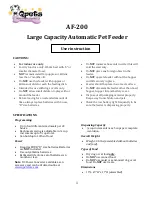
12
Wavin AS+
Technical Manual
Phone. +31(0)38 42 94 951
3.4. About Sound
Sound is a sensation felt, a perception of what takes place
around us, caused by various compression waves which
cross the eardrum and are captured and transformed by the
brain; it is composed of different frequencies. The acuteness
or intensity of the perception depends on the frequency and
range.
Sound is a wave that is:
Elastic (it needs a medium to be propagated)
Longitudinal (perturbation takes place parallel to the direc-
tion of propagation).
To exist it requires:
A source (vibrating body)
An elastic propagation medium (air, water, etc.)
A sound is therefore a method of transmitting mechanical
energy. To propagate, a sound needs a medium: any means,
whether solid, liquid or gassy, like air, is able to transport
sound, influencing its speed according to density.
Sound is propagated through the exchange of air-solid-air or
solid-air vibrations (in the second case the solid is the source
of the sound). With respect to soundproofing soil and waste
systems, we need to think in two different directions: (1) the
noise created in the pipes and transmitted by them and (2)
noise which is transmitted by the walls or surrounding media.
Sound is measured with a phonometer, an instrument which
filters noise and measures intensity at its different frequen-
cies. It is expressed in decibels.
The decibel is the logarithm of the ratio between the measu-
red sound pressure and a reference sound pressure, multip-
lied by ten.
dB = 10 log (P/Pa)
We need to remember that sound is an energy (just think
of when you stand in front of the stereo speakers and you
can “feel” the basses) but what we perceive is a processed
sensation.
The human ear is sensitive to pressure in a NON LINEAR
manner; therefore twice the pressure does not correspond to
twice the sensation.
The doubling of acoustic power corresponds to an
increase of 3 dB.
Every 10 dB increase is perceived by the human ear
as twice as loud (10 cars are perceived as twice as loud
as 1 car).
60 dB + 50 dB + 40 dB = 60.5 dB
The highest dB is in a sum the most important
10 cars of 60 dB = 70 dB
= twice as loud as 60 dB
1 car = 60 dB
2 cars = 63 dB
Sound intensity follows an inverse square law with distance
from the source; doubling the distance from a noise source
reduces its intensity by a factor of four, or 6 dB.
3.5. Noise
Noise can be described as unwanted sound. In relation to
sound, noise is not necessarily random.
Acoustic noise can be anything from quiet but annoying to
loud and harmful causing permanent irreversible hearing
damage.













































